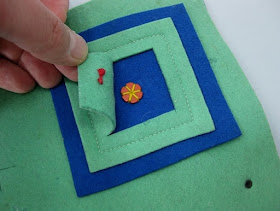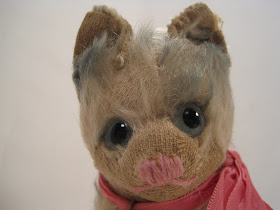No, you are not seeing stripes! Here we have a fantastic 100 cm Steiff Studio baby zebra. This black and white beauty is standing and made from off-white mohair which has been painstakingly hand stenciled with black stripes. He has a white and black mane down his back and his tail is tipped in long black mohair. The insides of his ears are lined in white dralon. Zebra has huge brown and black pupil eyes and mile-long blond eyelashes. Steiff made Studio zebras in 100 cm in 1960 and in 150 cm in 1960 and again in 1967.
According to his owner, this zebra was purchased at an antique show a few years ago in the mid-Atlantic area. The dealer was selling a few Steiff items on behalf of a friend, and sold this item to the collector "at a price to die for!"
Viewing this next Steiff treasure was a moving experience - literally. Here we have a fantastic example of a Steiff Automaton or moving window display. It measures overall about 18 inches deep by 24 inches wide by about 20 inches tall. The Automaton is made from wood; the background is stenciled with trees and the base is lined in short, green plush to resemble grass. The Automaton features two caramel colored mask Teddies, a blond mask Teddy, a woolen miniature black Hucky raven with plastic legs, a green woolen miniature frog, and a soft plush squirrel. When the Automaton is plugged in, the smaller caramel Teddy starts sawing the downed log, which is made from paper mache, and the larger Teddy drinks from his "honey" mug. Based on the animals in this Automaton, and their ear tags and buttons, it is Steiffgal's best estimate that this dynamic display was produced around 1984 or so.
According to its owner, this Automaton was purchased from an elderly woman who was looking to rehome her treasures to an enthusiastic collector. These Automatons can range in dimensions from a foot or so to several yards long; this is a wonderful example of a smaller scale one that could easily displayed and appreciated in most home collections.
No monkeying around with this next Steiff surprise! Here we have a delightful 35 cm example of Steiff's somewhat rare Schimpanse or Chimpanzee. He is a close relative to Steiff's beloved Jocko. Chimp is five ways jointed made from long brown tipped mohair. He has chunky limbs and felt hands, feet, and ears. His prominent brown and black glass pupil eyes are set dramatically into felt eye pocket. Chimp was made in 25, 30, 35, 40, and 100 cm from 1928 through 1934. A tail moves head version of this model was produced in nine sizes ranging from 13 through 66 cm from 1931 through 1934 as well.
According to his owner, this marvelous monkey was purchased for a song from an older collector who kept this pet outdoors on her porch for many years. That may explain why the chimp's felt hands and feet are a bit in distress - perhaps from moth damage - and why his mohair has faded overall to a light blond, except for in his joints and crotch area.
It's always a good idea to go out in big way, and this last find accomplishes that in largest way possible. No, your eyes do not deceive you. Here we have a 100 cm Studio Zotty bear - the very largest size of this design on record. This humongous heart throb was produced for one year - 1967 only. From the historical perspective, Zotty was one of the first new bear designs introduced after the Second World War, in 1951. He has appeared in the line, in one form or another, almost continuously since then. The early 1950's were an amazingly busy time at Steiff, as the company looked to rebuild its pre-war reputation for quality, while at the same time introduce new, innovative, contemporary designs to an expanding global marketplace. Zotty’s debut was one of the most significant efforts towards those goals. To “qualify” as a Zotty, a Steiff Teddy bears needs these three things: an open felt lined mouth; a front insert bib made of a complementary colored mohair to his body; and of course, be made from very shaggy material. Overall, Steiff's original mohair Zotty was produced in nine sizes, ranging from 17 through 100 centimeters, from 1951 through 1978.
According to his owner, this tremendous Ted was purchased at a yardsale around 25 years ago. And for how much at the time? Are you sitting down, with a seatbelt on? If so, read on... because he joined her hug for a mere $5. See, Steiff dreams can come true!
Steiffgal hopes this "brag book" of Steiff treasures from the Teddies of Mt. Holly Show has added an interesting chapter to your Steiff day.
Have a question about one of your Steiff treasures? Let's talk! Click here to learn more!



















